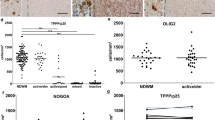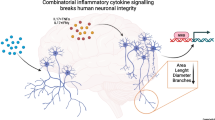Abstract
Background
The histopathology of multiple sclerosis (MS) is characterized by a loss of myelin and oligodendrocytes, relative preservation of axons, and a modest inflammatory response. The reasons for this selective oligodendrocyte death and demyelination are unknown.
Materials and Methods
In light of the T lymphocyte and macrophage infiltrates in MS lesions and the numerous cytokines these cells secrete, the direct influence of cytokines on survival of cultured oligodendrocytes and sensory neurons was investigated. Expression of cytokines in vivo was determined by immunolabeling cryostat sections of snap-frozen tissue containing chronic active lesions from four different patients. The samples were also analyzed for the presence of apoptotic nuclei by in situ labeling of 3′-OH ends of degraded nuclear DNA.
Results
The results showed: (i) interferon-γ (IFNγ) to be a potent inducer of apoptosis among oligodendrocytes in vitro and that this effect can be reversed by leukemia inhibitory factor (LIF); (ii) IFNγ has a minimal effect on the survival of cultured neurons; (iii) IFNγ at the margins of active MS plaques but not in unaffected white matter; (iv) evidence for apoptosis of oligodendrocytes at the advancing margins of chronic active MS plaques.
Conclusions
Injury to a substantial number of oligodendrocytes in MS is the result of programmed cell death rather than necrotic cell death mechanisms. We postulate that IFNγ plays a role in the pathogenesis of MS by activating apoptosis in oligodendrocytes.







Similar content being viewed by others
References
Dawson JW. (1916) The histology of disseminated sclerosis. Trans. R. Soc. Edinburgh 50: 517–740.
Lumsden CE. (1985) In: Vinken PJ, Bruyn GW (eds) Handbook of Clinical Neurology: The Neuropathology of Multiple Sclerosis. Elsevier Science, Amsterdam, Vol. 9, pp. 217–309.
Raine CS, Scheinberg L, Waltz JM. (1981) Oligodendrocyte survival and proliferation in an active established lesion. Lab. Invest. 45: 534–546.
Matthews WB, Compston A, Allen IV, Martyn CN (eds). (1991) McAlpine’s Multiple Sclerosis. Churchill Livingstone, New York, pp. 379–390.
Gulcher J, Vartanian T, Stefansson K. (in press) Is multiple sclerosis an autoimmune disease? Clin. Neurosci.
Griffin DE, Moser HW, Mendoza Q, et al. (1985) Identification of the inflamatory cells in the central nervous system of patients with adrenoleukodystrphy. Ann. Neurol. 18: 660–669.
Hirano A, Dembitzer HM, Becker NH, et al. (1970) Fine structure alterations of the blood brain barrier in experimental allergic encephalomyelitis. J. Neuropathol. Exp. Neurol. 29: 432–440.
Compston A, Scolding N, Wren D, Noble M. (1991) The pathogenesis of demyelinating disease: Insights from cell biology. Trends Neurosci. 14: 175–182.
Wren DR, Noble M. (1989) Oligodendrocytes and O2A progenitor cells of adult rats are specifically susceptible to the lytic effects of complement in the absence of antibody. Proc. Natl. Acad. Sci. U.S.A. 86: 9025–9029.
Scolding NJ, Morgan BP, Houston WAJ, et al. (1989) Vesicular removal by oligodendrocytes of membrane attack complexes formed by complement. Nature 339: 620–622.
Reder AT, Arnason BGW. (1985) In: Vinken PJ, Bruyn GW (eds) Handbook of Clinical Neurology: Demyelinating Diseases. Elsevier Science, Amsterdam, Vol. 3, pp. 337–395.
Hafler DA, Weiner HL. (1987) T cells in multiple sclerosis and inflammatory central nervous system diseases. Immunol. Rev. 100: 308–332.
Hauser SL, Bhan AK, Gilles F, et al. (1986) Immunohistochemical analysis of the cellular infiltrate in multiple sclerosis lesions. Ann. Neurol. 19: 578–587.
Booss J, Esiri MM, Tourtellotte WW, et al. (1983) Immunohistochemical analysis of T-lymphocyte subsets in the central nervous system in chronic progressive multiple sclerosis. J. Neurol. Sci. 62: 19–32.
Traugott U, Reinher EL, Raine CS. (1983) Multiple Sclerosis: Distribution of T-cell subsets within chronic active lesions. Science 219: 308–310.
Prineas JW, Kwon EE, Goldenberg PZ, et al. (1989) Multiple sclerosis: Oligodendrocyte proliferation and differentiation in fresh lesions. Lab. Invest. 5: 489–503.
Kerr JF, Wyllie AH, Currie AR. (1972) Apoptosis: A basic biological phenomenon with wide-ranging implications in tissue genetics. Br. J. Cancer 26: 239–257.
Raff MC. (1992) Social controls on cell survival and cell death. Nature 356: 397–400.
Williams GT, Smith CA. (1993) Molecular regulation of apoptosis: Genetic controls on cell death. Cell 74: 777–779.
Vaux DL. (1993) Toward an understanding of the molecular mechanisms of physiologic cell death. Proc. Natl. Acad. Sci. U.S.A. 90: 786–789.
Barres BA, Hart IK, Coles HSR, et al. (1992) Cell death and control of cell survival in the oligodendrocyte lineage. Cell 70: 31–46.
Barres BA, Schmid R, Sendtner M, Raff MC. (1993) Multiple extracellular signals are required for long-term oligodendrocyte survival. Development 118: 283–295.
Traugott U, Lebon J. (1988) Interferon-γ and Ia antigen are present on astrocytes in active chronic multiple sclerosis lesions. Neurol. Sci. 84: 257–264.
Sommer I, Schachner M. (1981) Monoclonal antibodies (O1 to O4) to oligodendrocyte cell surfaces: an immunocytochemical study in 742 the central nervous system. Dev. Biol. 83: 311–327.
Gavrieli Y, Sherman Y, Ben-Sasson A. (1992) Identification of programmed cell death in situ via specific labeling of nuclear DNA fragmentation. J. Cell. Biol. 119: 493–501.
McCarthy K, de Vellis JJ. (1980) Preparation of separate astroglial and oligodendroglial cell cultures from rat cerebral tissue. J. Cell. Biol. 85: 890–892.
Giulian D, Baker TJ. (1986) Characterization of ameboid mocroglia isolated from developing mammalian brain. J. Neurosci. 6: 2163–2178.
Carmichael J, DeGraff WG, Gazdar AF, et al. (1987) Evolution of tetrazolium-based semi-automated colorimetric assay: Assessment of chemosensitivity testing. Cancer Res. 47: 936.
Louis J-C, Magal E, Takayama S, Varon S. (1993) CNTF protection of oligos against natural and tumor necrosis factor-induced death. Science 259: 689–692.
Rosenbaum DM, Michaelson M, Batter DK, et al. (1994) Evidence for hypoxia-induced programmed cell death of cultured neurons. Ann. Neurol. 36: 864–870.
Raff MC, Miller RH, Noble M. (1993) A glial progenitor cell that develops in vitro into and astrocyte or an oligodendrocyte depending on culture medium. Nature 303: 390–396.
Gard AL, Pfeiffer SE. (1990) Two proliferative stages of the oligodendrocyte lineage (A2B5+O4− and O4+GalC−) under different mitogenic control. Neuron 5: 615–625.
Raff MC, Mirsky R, Fields KL, et al. (1978) Galacterocerebroside is a specific cell surface antigenic marker for oligodendrocytes in culture. Nature 274: 813–816.
Wren D, Wolswijk G, Noble M. (1992) In vitro analysis of the origin and maintenance of O2A (adult) progenitor cells. J. Cell. Biol. 116: 167–176.
Arenzana-Seisdedos F, Virelizier JL. (1983) Interferons as macrophage-activating factors II. Enhanced secretion of interleukin 1 by lipopolysaccharide-stimulated human monocytes. Eur. J. Immunol. 13: 437–440.
Banati RB, Gehrmann J, Schubert P, Kreutzberg GW. (1993) Cytotoxicity of microglia. Glia 7: 111–118.
Selmaj KW, Raine CS. (1988) Tumor necrosis factor mediates myelin and olgiodendrocyte damage in vitro. Ann. Neurol. 23: 339–346.
Merrill JE, Ignarro LJ, Sherman MP, et al. (1993) Microglial cell cytotoxicity of oligodendrocytes is mediated through nitric oxide. J. Immunol. 151: 2132–2141.
Dawson TM, Bredt DS, Fotuhi M, et al. (1988) Nitric oxide synthase and neuronal NADPH diaphorase are identicle in brain and peripheral tissues. Proc. Natl. Acad. Sci. U.S.A. 88: 7797–7801.
Hope BT, Michael GJ, Knigge KM, et al. (1988) Neuronal NADPH-diaphorase is a nitric oxide synthase. Proc. Natl. Acad. Sci. U.S.A. 88: 2811–2814.
Kleitman N, Wood PM, Bunge RP. (1991) Tissue culture methods for the study of myelination. In: Banker G, Goslin K (Eds). Culturing Nerve Cells. MIT Press, Cambridge, MA pp. 335–377.
Arends MJ, Morris RG, Wyllie AH. (1990) The role of the endonuclease. Am. J. Pathol. 136: 593–608.
Linington C, Webb M, Woodhams PL. (1984) A novel myelin-associated glycoprotein defined by a mouse monoclonal antibody. J. Neuroimmunol. 6: 387–396.
Panitch HS, Haley AS, Hirsch RL, Johnson KP. (1987) Exacerbations of multiple sclerosis in patients treated with gamma interferon. Lancet 1: 893–895.
Arnason BGW. (1993) Interferon beta in multiple sclerosis. Neurology 43: 641–643.
Salonen R. (1983) CSF and serum interferon in multiple sclerosis: A longitudinal study. Neurology 33: 1604–1606.
Beck J, Randot P, Catinot P, et al. (1988) Increased production of interferon-gamma and tumor necrosis factor preceding clinical manifestation in multiple sclerosis: Do cytokines trigger off exacerbations? Acta Neurol. Scand. 78: 318–323.
Maimone D, Gregory S, Arnason BGW, Reder AT. (1991) Cytokine levels in the cerebrospinal fluid and serum of patients with multiple sclerosis. J. Neuroimmunol. 32: 67–74.
Weller M, Stevens A, Sommer N, et al. (1991) Comparative analysis of cytokine patterns in immunological, infectious, and oncological neurological disorders. Neurol. Sci. 104: 215–221.
Merrill JE. (1992) Proinflammatory and antiinflammatory cytokines in multiple sclerosis and central nervous system acquired immunodeficiency 743 syndrome. J. Immunotherapy 12: 167–170.
Imamura K, Suzamura A, Hayashi F, Marunouchi T. (1993) Cytokine production by peripheral blood monocytes/macrophages in multiple sclerosis patients. Acta Neurol. Scand. 87: 281–285.
Simmons RD, Willenborg DO. (1990) Direct injection of cytokines into the spinal cord causes autoimmune encephalomyelitis-like inflammation. J. Neurol. Sci. 100: 37–42.
Benveniste EN. (1992) Inflammatory cytokines within the central nervous system: Sources, function, and mechanism of action. Am. J. Physiol. 263: C1–C16.
Olson T. (1992) Cytokines in neuroinflammatory disease: Role of myelin autoreactive T cell production of interferon-gamma. J. Neuroimmunol. 40: 211–218.
Vass K, Heininger K, Schafer B, et al. (1992) Interferon-γ potentiates antibody-mediated demyelination in vivo. Ann. Neurol. 32: 198–206.
Bergsteinsdottir K, Brennan A, Jessen KR, Mirsky R. (1992) In the presence of dexamethasone, gamma interferon induces rat oligodendrocytes to express major histocomplatibility complex class II molecules. Proc. Natl. Acad. Sci. U.S.A. 89: 9054–9058.
Oka A, Belliveau MJ, Rosenberg PA, Volpe JJ. (1993) Vulnerability of oligodendroglia to glutamate: Pharmacology, mechanisms, and prevention. J. Neurosci. 13: 1441–1453.
Eitan S, Zisling R, Cohen A, et al. (1992) Identification of an interleukin 2-like substance as a factor cytotoxic to oligodendrocytes and associated with central nervous system regeneration. Proc. Natl. Acad. Sci. U.S.A. 89: 5442–5446.
Patneau DK, Wright PW, Winters C, Mayer ML, Gallo V. (1994) Glial cells of the oligodendrocyte lineage express both kainate-and AMPA-preferring subtypes of the glutamate receptor. Neuron 12: 357–371.
Pende M, Holtzclaw LA, Curtis JL, Russell JT, Gallo V. (1994) Glutamate regulates intracellular calcium and gene expression in oligodendrocyte progenitors through the activation of AMPA receptors. Proc. Natl. Acad. Sci. U.S.A. 91: 3215–3219.
Grau GE, Fajardo LF, Piguet PF, et al. (1987) Tumor necrosis factor (cachectin) as an essential mediator in murine cerebral malaria. Science 237: 1210–1212.
The IFN-β Multiple Sclerosis Study Group. (1993) Interferon beta-Ib is effective in relapsing-remitting multiple sclerosis. Neurology 43: 655–661.
Paty DW, Li DKB. (1993) The IFNβ Multiple Sclerosis Study Group. Interferon beta-lB is effective in relapsing-remitting multiple sclerosis. Neurology 43: 662–667.
Acknowledgments
Tissue specimens obtained from the National Neurological Research Specimen Bank, VAMC, Los Angeles, CA 90073, which is sponsored by NINDS/NIMH, National Multiple Sclerosis Society, Hereditary Disease Foundation, Comprehensive Epilepsy Program, Tourette Syndrome Association, Dystonia Medical Research Foundation, and Veterans Health Services and Research Administration, Department of Veterans Affairs.
This work was supported in part by grants from the National Institutes of Health. T. Vartanian is a recipient of a Clinical Investigator Development Award from the National Institute of Neurologic Disorders and Stroke.
Author information
Authors and Affiliations
Additional information
Contributed by R. Cotran on July 8, 1995.
Rights and permissions
About this article
Cite this article
Vartanian, T., Li, Y., Zhao, M. et al. Interferon-γ-Induced Oligodendrocyte Cell Death: Implications for the Pathogenesis of Multiple Sclerosis. Mol Med 1, 732–743 (1995). https://doi.org/10.1007/BF03401888
Published:
Issue Date:
DOI: https://doi.org/10.1007/BF03401888




